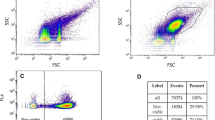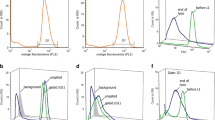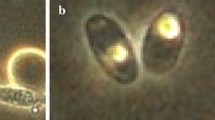Abstract
The physiological status and metabolic heterogeneity of Bacillus cereus cells within a culture during an 8-h batch fermentation process was measured using flow cytometry (FCM). Concurrently, production of the toxin, PC-PLC, and the extent of cell adhesion of live and dead cells were monitored using novel fluorescent assays. Flow cytometry analysis detected growth phase-related changes in the physiological profiles of cells over the course of the fermentation, with variation in the percentage of cells displaying membrane damage and intracellular esterase and redox activities. As the exponential phase proceeded, populations became more uniform in terms of protein content as measured using FCM in tandem with a cell tracking dye, with the majority of cells becoming membrane intact, esterase positive and redox active. PC-PLC activity appeared strongly related to cell density. Permeabilisation of cells was accompanied by a loss in adherent properties, while 25–100% of cells with intracellular esterase activity possessed adhesion properties. Cells in late exponential phase appeared to have reduced adherence properties compared to cells in early exponential or lag phase. As well as demonstrating the utility of FCM for measuring heterogeneity in terms of cell physiological status throughout the course of batch cultures, the methods utilised in this study could be used to relate processes such as toxin production or cell adhesion to cell physiological state.






Similar content being viewed by others
References
Dahl MK (1999) Bacillus subtilis. In: Robinson JP, Batt CA, Patel PD (eds) Encyclopedia of food microbiology. Academic Press, New York, pp 135–141
Ueckert JE, Nebe-von-Caron G, Bos AP, ter Steeg PF (1997) Flow cytometric analysis of Lactobacillis plantarum to monitor lag times, cell division and injury. Lett Appl Microbiol 25:295–299
Hewitt CJ, Nebe-von-Caron G (2001) An industrial application of multiparameter flow cytometry: assessment of cell physiological state and its application to the study of microbial fermentations. Cytometry 44:179–187
Wallberg F, Sundstrom H, Ledung E, Hewitt CJ, Enfors S-O (2005) Monitoring and quantification of inclusion body formation in Escherichia coli by multi-parameter flow cytometry. Biotechnol Lett 27:919–926
Reis A, Lopes da Silva T, Kent CA, Kosseva M, Roseiro JC, Hewitt CJ (2005) Monitoring population dynamics of the thermophilic Bacillus licheniformis CCMI 1034 in batch and continuous cultures using multi-parameter flow cytometry. J Biotechnol 115:199–210
Lopes da Silva T, Reis A, Kent CA, Kosseva M, Roseiro JC, Hewitt CJ (2005) Stress-induced physiological responses to starvation periods as well as glucose and lactose pulses in Bacillus licheniformis CCMI 1034 continuous aerobic fermentation processes as measured by multi-parameter flow cytometry. Biochem Eng J 24:31–41
Lopez-Amoros R, Comas J, Carulla C, Vives-Rego J (1994) Variations if in flow cytometric forward scatter signals and cell size in batch cultures of Escherichia coli. FEMS Microbiol Lett 117:225–230
Natarajan A, Srienc F (2000) Glucose uptake rates of single E.coli cells grown in glucose-limited chemostat cultures. J Microbiol Method 42:87–96
Steen HB, Boye E (1980) Bacterial growth studied by flow cytometry. Cytometry 1:32–36
Haidinger W, Szostak MP, Jechlinger W, Lubitz W (2003) Online monitoring of Escherichia coli ghost production. Appl Environ Microbiol 69:468–474
Maskow T, Muller S, Losche A, Harms H, Kemp R (2005) Control of continuous polyhydroxybutyrate synthesis using calorimetry and flow cytometry. Biotechnol Bioeng 93:541–552
Muller S, Loffhagen N, Bley T, Babel W (1996) Membrane-potential-related fluorescence intensity indicates bacterial injury. Microbiol Res 151:127–131
Bailey JE, Fazel-Madjlessi J, McQuitty DN, Lee LY, Allred JC, Oro JA (1977) Characterization of bacterial growth by means of flow microfluorometry. Science 198:1175–1176
Beattie SH, Williams AG (1999) Detection of toxins. In: Robinson RK, Batt CA, Patel PD (eds) Encyclopedia of food microbiology. Academic Press, New York, pp 141–149
Bennet RW, Belay N (2001) Bacillus cereus. In: Downes FP, Ito K (eds) Microbiological examination of foods. American Public Health Association, Washington, DC, pp 311–316
Notermans S, Batt CA (1998) A risk assessment approach for food-borne Bacillus cereus and its toxins. J Appl Microbiol 84:51–61
Rowan NJ, Caldow G, Gemmell CG, Hunter IS (2003) Production of diarrhoeal enterotoxins and other potential virulence factors by veterinary isolates of Bacillus species associated with nongastrointestinal infections. Appl Environ Microbiol 69:2372–2376
Callegan MC, Jett BD, Hancock LE, Gilmore MS (1999) Role of haemolysin BL in the pathogenesis of extraintestinal Bacillus cereus infection assessed in an endophthalmitis model. Infect Immun 67:3357–3366
Beecher DJ, Olsen TW, Somers EB, Wong CL (2000) Evidence for contribution of tripartite haemolysin BL, phosphatidylcholine-preferring phospholipase C, and collagenases to virulence of Bacillus cereus endophthalmitis. Infect Immun 68:5269–5276
Titball RW (1998) Bacterial phospholipases. J Appl Microbiol 84:127S–137S
Ghelardi E, Celandroni F, Salvetti S, Barsotti C, Baggiani A, Senesi S (2002) Identification and characterization of toxigenic Bacillus cereus isolates responsible for two food-poisoning outbreaks. FEMS Microbiol Lett 208:129–134
Jaaskelainen EL, Haggblom MM, Andersson MA, Vanne L, Salkinoja-Salonen MS (2003) Potential of Bacillus cereus for producing an emetic toxin, cereulide, in bakery products:quantitative analysis by chemical and biological methods. J Food Prot 66:1047–1054
Sidhu MS, Olsen I (1997) S-layers of Bacillus species. Microbiol 143:1039–1052
Svensson B, Ekelund K, Ogura H, Christiansson A (2004) Characterisation of Bacillus cereus isolated from milk silo tanks at eight different dairy plants. Int Dairy J 14:17–27
Clavel T, Carlin F, Lairon D, Nguyen-The C, Schmitt P (2004) Survival of Bacillus cereus spores and vegetative cells in acid media simulating human stomach. J Appl Microbiol 97:214–219
Cronin UP, Wilkinson MG (2008) The physiological response of Bacillus cereus vegetative cells to simulated food processing treatments. J Food Prot (2008)
Lee TC, Lewis MJ (1968) Identifying nucleotidic materials released by fermenting brewer’s yeast. J Food Sci 33:119–123
Powers LS, Lloyd CR (2002) Method for detecting the presence of microbes and determining their physiological status, Microbiosystems, Limited Partnership, United States of America p 9 of 5978
Lyons AB (1999) Divided we stand: tracking cell proliferation with carboxyfluorescein diacetate succinimidyl ester. Immunol Cell Biol 77:509–515
Swinnen IAM, Bernaerts K, Dens EJJ, Geeraerd AH, van Impe JP (2004) Predictive modelling of the microbial lag phase: a review. Int J Food Microbiol 94:137–159
Hoefel D, Grooby WL, Monis PT, Andrews S, Saint CP (2003) Enumeration of water-borne bacteria using viability assays and flow cytometry: a comparison to culture-based techniques. J Microbiol Method 55:585–597
Finlay WJJ, Logan NA, Sutherland AD (2002) Bacillus cereus emetic toxin production in cooked rice. Food Microbiol 19:431–439
Banerjee M, Sarkar PK (2004) Growth and enterotoxin production by sporeforming bacterial pathogens from spices. Food Control 15:491–496
Dong Y, Gusti AR, Zhang Q, Xu J, Zhang L (2002) Identification of quorum-quenching N-acyl homoserine lactonases from Bacillus species. Appl Environ Microbiol 68:1754–1759
Griffiths MW (2005) Quorum-sensing and virulence in foodborne pathogens. In: Griffiths MW (ed) Understanding pathogen behaviour. CRC Press, New York, pp 549–597
Finlay WJJ, Logan NA, Sutherland AD (2002) Bacillus cereus emetic toxin production in relation to dissolved oxygen tension and sporulation. Food Microbiol 19:423–430
Lindsay D, Brozel VS, von Holy A (2006) Biofilm-spore response in Bacillus cereus and Bacillus subtilis during nutrient limitation. J Food Prot 69:1168–1172
Cronin UP, Wilkinson MG (2008) Bacillus cereus endospores exhibit a heterogeneous response to heat-treatment and low temperature storage. Food Microbiol 25:235–243
Acknowledgments
This work was supported by safefood––the Food Safety Promotion Board, Island of Ireland.
Author information
Authors and Affiliations
Corresponding author
Rights and permissions
About this article
Cite this article
Cronin, U.P., Wilkinson, M.G. Monitoring growth phase-related changes in phosphatidylcholine-specific phospholipase C production, adhesion properties and physiology of Bacillus cereus vegetative cells. J Ind Microbiol Biotechnol 35, 1695–1703 (2008). https://doi.org/10.1007/s10295-008-0461-3
Received:
Accepted:
Published:
Issue Date:
DOI: https://doi.org/10.1007/s10295-008-0461-3




